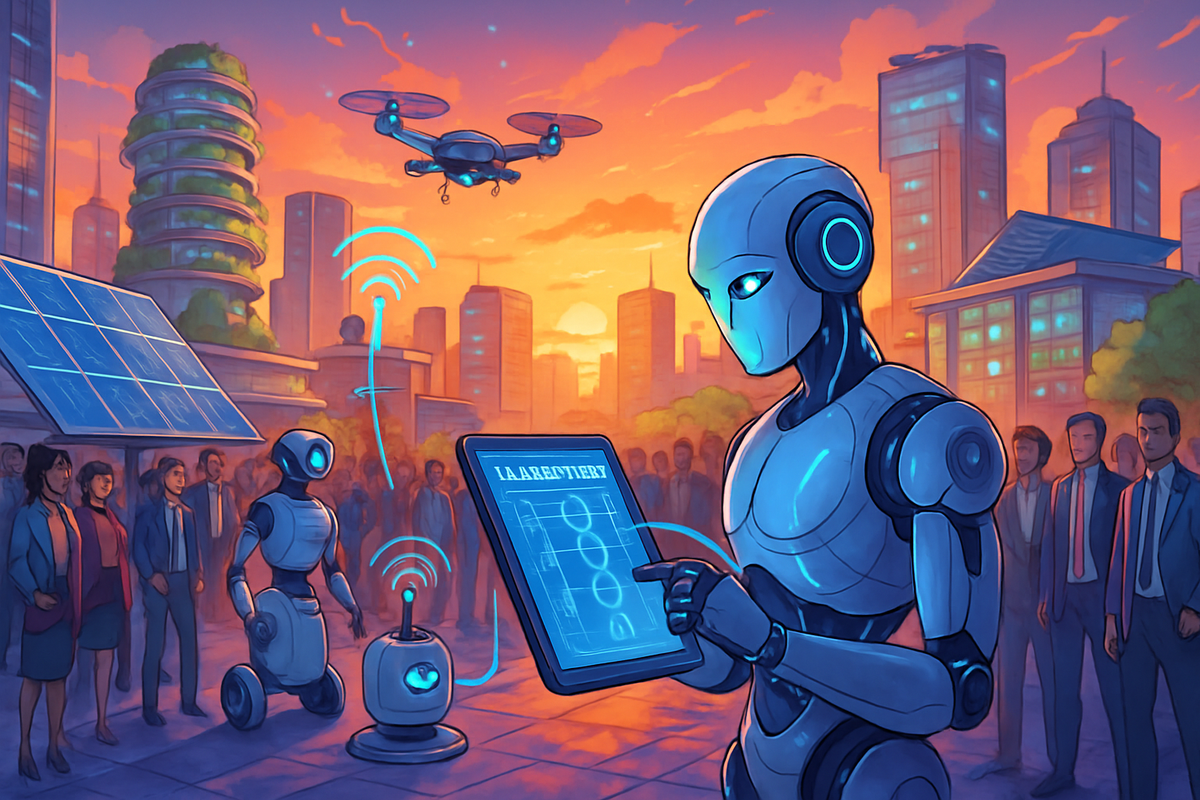The Rise of Decentralized Autonomous Machines: How AI, Blockchain, and IoT Are Creating a Post-Labor Economy
Imagine machines as economic agents negotiating deals, owning assets, and autonomously creating value. Decentralized Autonomous Machines are reshaping industries and economies—are you ready to explore this transformative future?

Published: August 10, 2025
"Imagine a world where machines not only work for us—they work for themselves, for each other, and, in a way, for everyone. Welcome to the dawn of Decentralized Autonomous Machines."
What Are Decentralized Autonomous Machines (DAMs)?
Picture this: a self-driving truck that schedules its own maintenance, pays for its own fuel, and negotiates delivery contracts—all without a human boss. Now, multiply that by a million: delivery drones, smart power grids, robot-run micro-factories, all operating with minimal human oversight, collaborating and trading value directly. This isn’t a sci-fi fever dream—it’s the emerging reality of Decentralized Autonomous Machines (DAMs).
DAMs are the ultimate tech team-up: AI brains for intelligent decision-making, blockchain ledgers for trust and transparency, and IoT devices to sense and act in the physical world. They’re not just robots; they’re economic agents—able to own assets, make contracts, and manage resources autonomously in what researchers call Decentralized Physical Infrastructure Networks (DePIN) (Castillo et al., 2025).
The Tech Stack: From Sci-Fi to Shop Floor
- Artificial Intelligence (AI): Empowers DAMs to make decisions, predict needs, and optimize performance—think smart scheduling, predictive maintenance, or instant supply chain recalibration.
- Blockchain: Provides immutable records, automates payments via smart contracts, and enables machines to own crypto wallets. No more, "Trust me, bro"—just code and consensus.
- Internet of Things (IoT): Connects physical sensors and actuators, bridging digital logic with real-world action. IoT is how a DAM knows when it’s time to water crops, recharge itself, or call in a drone for backup.
Together, these technologies create a new class of entities: machines that do business on our behalf—and sometimes, on their own.
Real-World Use Cases: Not Just for Tech Utopians
1. Autonomous Energy Grids
Solar panels, batteries, and wind turbines—each a DAM—can negotiate energy trades in real-time. If a neighborhood needs more juice, the grid’s DAMs cut deals with each other, optimizing for price and supply, all transparently logged on blockchain. No middlemen, no blackouts, no "Did you turn off the lights?" texts from your dad.
2. Self-Managed Logistics
Fleet vehicles become their own dispatchers. A delivery van could autonomously contract for routes, pay tolls, and even invest its surplus earnings in other digital assets—without ever clocking in or out.
3. Decentralized Infrastructure
DAMs maintain public assets: think smart roads that pay for their own repairs, or water pipes that order replacement parts before they burst. Maintenance becomes proactive, not reactive—and costs are shared across a community via transparent, automated micro-payments.
Why It Matters: Toward a Post-Labor Economy?
"DAMs could be the great equalizer—democratizing access to wealth and opportunity by decentralizing ownership and automating value creation."
Here’s the kicker: if machines can own and manage assets, the need for traditional human labor in many sectors could shrink dramatically. This isn’t just about job loss; it’s about new ways to participate in the economy—from community-owned energy grids to citizen-governed delivery networks.
- Wealth redistribution: DAMs can be programmed to share profits with stakeholders—imagine owning a slice of a robot-run farm or delivery network.
- Universal access: By lowering barriers to entry, DAMs may let anyone participate in digital-first economies, regardless of geography or background.
- Resilience: Decentralized networks are less prone to single points of failure, corruption, or manipulation.
Of course, this isn’t a utopia-on-autopilot. It raises big questions about governance, security, and the future of work. But the possibilities are as thrilling as they are disruptive.
Challenges & Cautions: Not All Sunshine and Smart Contracts
- Security: Autonomous machines are juicy targets for hackers. Securing the machine-to-machine economy is job #1.
- Ethics & Governance: Who sets the rules for DAMs? Who’s responsible when things go haywire? We’ll need robust, transparent governance models.
- Digital Divide: Not everyone has equal access to DAM infrastructure—bridging this gap is essential to avoid new forms of inequality.
Still, the genie is out of the bottle. The question is not if, but how we’ll adapt to these new digital citizens.
How to Get Involved: From Curiosity to Capital
Feeling a tingle of FOMO? Here’s how you can plug in:
- Stay Informed: Subscribe to Funaix Insider for free. We break down the wild world of future tech, and only subscribers can join the conversation in our comments (and yes, it’s free for now!).
- Upskill: Explore online courses in AI, blockchain, and IoT—you don’t need to be a coder to understand the basics and spot opportunities.
- Experiment: Dip your toes into decentralized apps, invest in tokenized infrastructure, or join a pilot project in your community.
- Advocate: Push for open, ethical governance of DAMs—because the future should serve everyone, not just the early adopters with fast Wi-Fi.
The Big Picture: Are We Ready for a World Where Machines Make Money?
Decentralized Autonomous Machines are more than just a tech trend—they’re a leap toward post-labor economics, where value creation is automated, and opportunities are open-source. Whether you’re a techie, investor, policymaker, or a curious bystander, now’s the moment to pay attention.
Want to shape the conversation—and read or write comments on the future of DAMs?
Subscribe to Funaix—it’s free, for now. Only subscribers get full access to our community and smart news perks.
Become a Funaix Insider
Sources: Castillo et al., 2025; arXivCurious for more? Join our subscriber community for exclusive commentary, smart news, and member-only insights on the automation economy.




